
Heart Mountain, Wyoming

Map of the camp. |
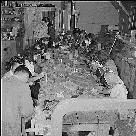
A class of early teen age students of Japanese ancestry, in a craft shop at the Heart Mountain Relocation Center. Under trained supervision, students learn to make art objects of wood and paper. |
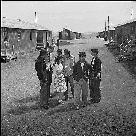
Heart Mountain high school campus scene. Classes are housed in tarpaper-covered, barrack-style buildings originally designed as living quarters for the evacuees. |
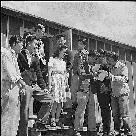
A group of students gathers around the entrance to the principal's office with Ralph Forysthe, assistant principal. It has since been learned that Ted Fujioka, a private first class, was killed on a special mission in France during the week of November 19, 1944. |
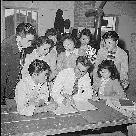
A part of the Echoes staff gathers for a conference with Sidney Melby, faculty journalism adviser in one corner of the Sentinel office. |
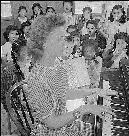
A fourth grade rhythm class in the grade school of the Heart Mountain Relocation Center, where persons of Japanese ancestry, evacuated from the west coast now reside. |
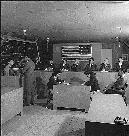 A session of the court at the Heart Mountain Relocation Center. The court is composed of seven judges selected from the residents and appointed by the Project Director. They preside over infractions of center regulations and ordinary civil court cases. |
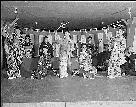 > > A demonstration of the theatrical folk lore of old Japan, as presented by group players at this relocation center. |
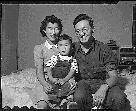
A typical Nisei family, Bill, Alice and Young Mike Hosokawa. Bill is editor of the Heart Mountain Sentinel. Heart Mountain Relocation Center newspaper. |
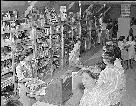
Typical scene in the Community Enterprise Stores at the Heart Mountain Relocation Center. Chief stocked items are tobacco, drug sundries, a limited supply of canned and packaged groceries and general notions. Stores are operated on a cooperative basis. The limited profit is returned to the evacuee residents. |
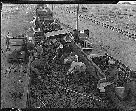
It takes approximately four carloads of coal a day to provide heat for residents at this Wyoming relocation center during the cold winter months. Here a crew of men loading trucks from the coal gondola for delivery to barracks. |
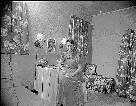
With a few yards of cloth and a nick nack or two, Miss Adeline Story, Caucasian teacher, has made her small dormitory room a comfortable spot. |
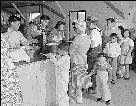
Dinner is served caffeteria style to young and old in the mess halls at the Heart Mountain Relocation Center. |
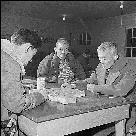
"Shogi" - a game very similar to "Chess", is played in a recreation hall by persons of Japanese ancestry, evacuated from west coast areas. |

One of the plaques at the camp site. |

Another plaque at the camp site. |
 Plaque
|
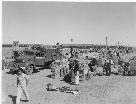 As carloads of personal belongings arrived at this relocation center, they were taken to the central square and sorted alphabetically and distributed to the barracks. 9/14/42
|
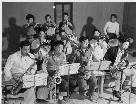 Swing Band practice--a strictly hep gang directly in the groove. The boys play at mess hall dances which generally end up in a straight jitterbug contest. 9/12/42
|
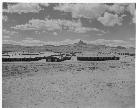 Looking west over the Heart Mountain Relocation Center with its sentry name sake Heart Mountain on the horizon. 9/18/42
|
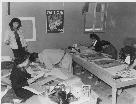 A crew of poster artists preparing Caution and Fire Hazard posters in an early campaign for the prevention of fire, greatest danger to the initial inhabitants of the Heart Mountain Relocation Center.
|
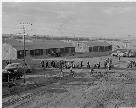 One of the last group of arrivals at the relocation center cross the warehouse area from the railroad platform to the registration office.
|
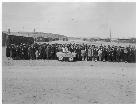 Funeral picture taken for Mr. J. Fukui. 9/18/42
|
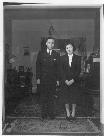 Heart Mountain's first bride and groom pose after the ceremony at a minister's home in Cody, Wyoming.. 9/18/42
|
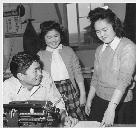 Albert Saijo, second semester editor of Echoes, Heart Mountain high school publication, talks things over with Hisako Takehara and Alice Tanouye, first semester co-editors.
|
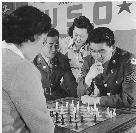 Visiting soldiers from the Army of the United States are entertained in the Heart Mountain Center where persons of Japanese ancestry, evacuated from west coast defense areas, now reside; by girls of the Heart Mountain USO, the only nationally recognized USO chapter operating within a relocation center. 6/4/43
|
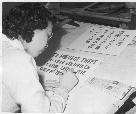 In the poster shop at the Heart Mountain Relocation Center, a young artist completes the first draft of a general store notice. The picture also shows the Japanese version of the same notice, which will also be posted for the benefit of the older persons who cannot read English.
|
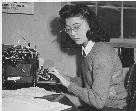 Reporter Kay Masuda of the Sentinel staff, Heart Mountain Relocation Center 's 8-page tabloid newspaper, which is published entirely by center residents of Japanese ancestry.
|
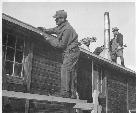 To increase school facilities, several abandoned CCC buildings were moved from a former CCC camp to the Heart Mountain Relocation Center. Here, resident workers are reassembling the buildings. 1/4/43
|
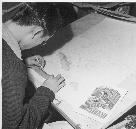 A young Nisei artist in the Poster Shop at the Heart Mountain Relocation Center prepares the final sketch on a poster, which is part of the drive at the center to save rubber. 1/5/43
|
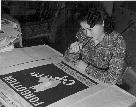 A young artist of Japanese parentage, correcting a poster in the Poster Shop at the Heart Mountain Relocation Center. Posters, such as this, for safety, fire prevention, general notices and various campaigns are reproduced by silk screen in the Poster Shop, which is operated by resident artists. 1/5/43
|
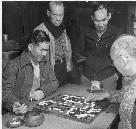 A group of centerites gather around two of the center's expert Go players. The game, popularly conceived as a game of military strategy, it is more nearly a battle of keen wits, though even this has been frustrated by a six year old boy who recently defeated 13 players in simultaneous games at this center. 1/4/43
|
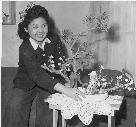 Ruby Hifumi, 16 year old high school student with a special New Year's flower arrangement. The material is a piece of pine, a sprig of sage with paper flowers indicating a plum tree and a paper bamboo. The flower arrangement of the three materials symbolizes in order, hardiness, courage and strength.
|
 Registering for housing accommodations.
|
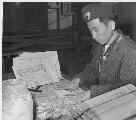 A member of the staff of the Sentinel, Heart Mountain Relocation Center newspaper, wraps labels and addresses of Sentinel for outside mailing. The Sentinel's coherent voice of center residents, relocated persons of Japanese ancestry, has a wide circulation outside the center. Its editor, Bill Hosokawa, is a Washington U. graduate, a former west coast newspaper man, foreign correspondent for the Singapore Times and Far East Review, and editor of the Singapore Herald. 1/8/43
|
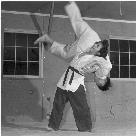 In a class for girls, an advanced girl student throws a male Judo instructor. Not generally considered a sport for girls, a class of 30 young girls of Japanese ancestry, residing at Heart Mountain, found the sport a benefit to physical condition and quite a little help to them for beauty problems. 1/7/43
|
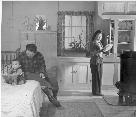 A few pieces of scrap and some additional mail order lumber, and the ingenuity of skilled hands, have converted a bare barracks room into a home of some comfort. Many residents, such as the young Nisei family shown, have through their own ingenuity, bettered their living conditions within the center.
|
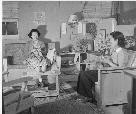 Mrs. S. Nako entertains a friend, Mrs. William Hosokawa, for an afternoon's knitting. Starting with a bare barracks room, some scrap and some mail order lumber and much ingenuity, S. Nako, a young Nisei, constructed the typically modern furniture shown.. 1/8/43
|
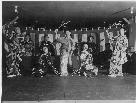 A demonstration of the theatrical folk lore of old Japan, as presented by players at this relocation center. 9/17/42
|
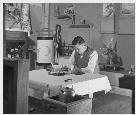 Out of small bits of scrap lumber and wall board, M. Imafuji has created in his barracks home, an atmosphere of oriental charm. The low table, standing lantern, the screen and the scroll serve a double purpose of carrying out a theme remembered from childhood days in the orient. M. Imafuji, though he likes his oriental decorations, is a member of the American Legion and served with the A.E.F. 1/7/43
|
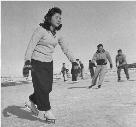 By the third time he had been to an ice skating rink, the thing to do is set off with confidence. This young Nisei girl of Japanese ancestry now residing at Heart Mountain has a look of determination as she masters a new sport for former Californians. 1/10/43
|
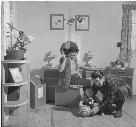 The Howard Hisayan family in one corner of their barracks home. The furniture, constructed with much ingenuity by Howard, was made from scrap lumber and mail order material. Howard is foreman of the warehouse where he keeps track of supplies from food to machinery. Seattle born, he was a resident of El Monte, California, before the evacuation of all persons of Japanese ancestry from that area. 1/9/43
|
 A young Nisei girl, Helen Hifumi, 13, a high school student at the Heart Mountain Center High School where classes are held temporarily in barracks blocks. 1/9/43
|
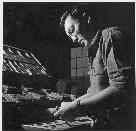 In the press room of the Cody Enterprise, Bill Hosokawa, Editor of the Sentinel, Heart Mountain Relocation Center newspaper, sets type for the final makeup of the weekly edition. Bill, a former foreign correspondent and Washington U. graduate, sets type, pulls proofs, operates the Linotype, locks forms, is capable of performing any of the tasks in order to put his paper to bed.
|
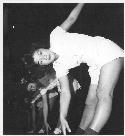 Keeping a trim figure is a chief concern of any young American girl, regardless of ancestry. This scene, in the Heart Mountain Gymnasium, shows a group of young evacuees keeping fit. 11/17/43
|
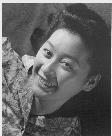 Typical of the young girls at the Heart Mountain Relocation Center is attractive Janice Shirota. 11/25/43
|
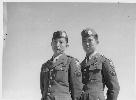 T/C Kazuo Yoshida (left) and T/C Clarence Ota (right) visited Heart Mountain. They are originally from Hawaii--volunteered for the 442nd Combat Team, but were deferred because the quota had been filled. They were later accepted as volunteers for the Army Intelligence School at Camp Savage, where they completed their course of training. Later volunteered for the Paratroop School at Ft. Benning, Georgia, and completed the four week training course in the Airborne Infantry. Now awaiting permanent assignment to a regular Airborne Unit.
|
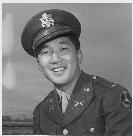 Second Lieutenant Moe Yonemura is with Company C, 442nd Division at Camp Shelby Mississippi. He recently returned from Fort Benning, Georgia, after four months of intensive training at the Officers Candidate School. Lieutenant Yonemura is a graduate of the University of California, Los Angeles--class of '42--where he was official yell leader of the school. He also was a member of the following Honor Societies: Blue Key, Scabbard and The Blade. Before entering the Army, Lieutenant Yonemura was a member of the National R.O.T.C. at University of California, Los Angeles, as a Cadet Captain
|
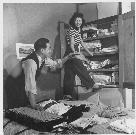 Busily preparing to leave the Center for outside employment are Mr. ad Mrs. Robert Kodama. The Kodamas formerly lived in Los Angeles, California, where Robert was employed by the Jr. Produce Club as Office Manager. While living in Los Angeles, Mrs. Kodama was employed by the California State Controllers Office as Steno-Receptionist. 3/18/44
|
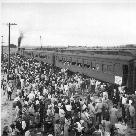 Reversing the scenes of nearly three years ago when train after train brought more than 11,000 evacuees from the West coast, Heart Mountain residents now are bidding goodbye to friends and neighbors as they return to their homes or depart for new homes and work throughout the nation. This scene taken at a recent departure shows the largest group to date to be taken away from their wartime home. Four to six coaches have been leaving the Heart Mountain Center weekly for Billings, Montana, where they will connect with the mainliners both East and west.
|
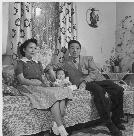 A typical Nisei family of Heart Mountain Relocation Center are Mr. and Mrs. Thomas Oki and their small daughter, Dinne. At the present time, Tom is block manager of block 25 at the center. The Okis formerly resided in Hollywood, California, where Mr. Oki was employed by the Hanford Laboratory (research medical bacteriologist). Tom is a graduate of Stanford University--class of '39--where he obtained his degree in bacteriology.
|
 Arrivals leaving train assisted by Girl Scout with their baggage
|
Construction was started on June 15, 1942. The first evacuees arrived on August 11, and the center was in operation until Nov.10. It's maximum population was over 10,000. Heart Mountain had the highest rate of draft resistance, with a total of 85 men imprisoned.
From the Final Report: Japanese Evacuation from the West Coast 1942, published June 5, 1943, a description of the site:"This Project site is located in Park County, northwestern Wyoming, and is in the Heart Mountain Irrigation Division of the Shoshone Project of the Bureau of Reclamation. It consists of some 46,000 acres most of which is irrigable land. The land was public domain and was secured from the Department of the Interior. The soils vary from light sandy to heavy clay. The principal crops are alfalfa, beans, sugar beets, seed peas, potatoes, soy beans and small grains. Conditions are generally favorable for dairying and poultry raising.
"Temperatures in this area range from a maximum of 101 degrees above zero to a minimum of 30 degrees below zero. The frost-free season extends from the end of May to the middle of September. Rainfall averages 5 1/2 inches per year."
 The Oakland Tribune, Aug. 29, 1942 |
 The Gettysburg Times, June 17, 1943 |
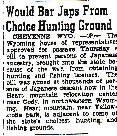 The Bismarck Tribune, Feb. 2, 1945 |
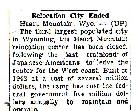 The Sheboygan Press, Dec. 21, 1945 |
The first article is pretty standard, just dealing with the movement of the Japanese Americans to Heart Mountain. The second article is about alleged illegal doings at the camp, involving hoards of food stocks and the trading of food for whiskey and chickens. The third article is a little strange, about a movement to make sure that the Japanese internees would not be allowed a fishing or a hunting license in the state. The last article is about the center being closed.
You Tube video of Heart Mountain
Heart Mountain Sentinel newsletter
Although there have been many books written about the Japanese-American internment, only some of them even mention the newsletters produced at the camps and, at most, they generally will have only one or two pages from one of the issues.
This is leaving out one of the most historically interesting and important aspects of the internment. The newsletters that were produced give the day-to-day news of interest to the community of those who were interned. I am sure that there were restraints on what the newsletters were allowed to print, but they still tend to contain a wealth of interesting material.
I ran across one particularly valuable source, Densho . They have a vast number of the newsletters. I found a few elsewhere.
The Heart Mountain Sentinel is like some other newsletters in that it did not start until after another publication ended, the first one being an Information Bulletin series. There are also some issues that are missing.
Information Bulletin Issues 1-5
Information Bulletin Issues 6-10
Information Bulletin Issues 11-15
Information Bulletin Issues 16-20
Information Bulletin Issues 21-28
Volume 1 #1-5
Volume 1 #6-10
Volume 2 #1-5
Volume 2 #6-10
Volume 2 #11-15
Volume 2 #16-20
Volume 2 #21-25
Volume 2 #26-30
Volume 2 #31-35
Volume 2 #36-40
Volume 2 #41-45
Volume 2 #46-52
Volume 3 #1-5
Volume 3 #6-10
Volume 3 #11-15
Volume 3 #16-20
Volume 3 #21-25
Volume 3 #26-30
Volume 3 #31-35
Volume 3 #36-40
Volume 3 #41-45
Volume 3 #46-52
Volume 4 #1-5
Volume 4 #6-10
Volume 4 #11-15
Volume 4 #16-20
Volume 4 #21-25
Volume 4 #26-31
Sentinel Supplement, Issues 1-20
Sentinel Supplement, Issues 21-40
Sentinel Supplement, Issues 41-60
Sentinel Supplement, Issues 61-74
Sentinel Supplement, Issues 91-110
Sentinel Supplement, Issues 111-130
Sentinel Supplement, Issues 131-150
Sentinel Supplement, Issues 151-170
Sentinel Supplement, Issues 171-190
Sentinel Supplement, Issues 191-210
Sentinel Supplement, Issues 211-230
Sentinel Supplement, Issues 231-250
Sentinel Supplement, Issues 251-270
Sentinel Supplement, Issues 271-290
Sentinel Supplement, Issues 291-310
Sentinel Supplement, Issues 311-330
Sentinel Supplelment, Issues 331-363
Coordinator's Bulletin
December 18, 1944 extra
Main Index
Japan main page
Japanese-American Internment Camps index page
Japan and World War II index page
|
|